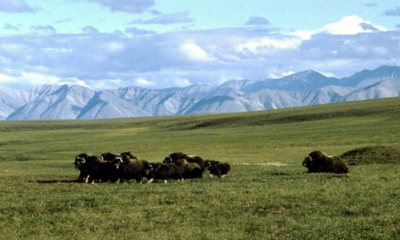Alaska
Anchorage, Alaska hit by hurricane-force winds, structures damaged across city

Associated Press
Hurricane-force winds cause widespread damage in Alaska’s largest city
Thousands of residents across Alaska’s largest city were still without power Monday, a day after a powerful storm brought hurricane-force winds that downed power lines, damaged trees, forced more than a dozen planes to divert, and caused a pedestrian bridge over a highway to partially collapse. A 132-mph (212-kph) wind gust was recorded at a mountain weather station south of Anchorage. A large low-pressure system in the Bering Sea brought the high winds, moisture and warmer than average temperatures — in the low 40s Fahrenheit (slightly over 4.4 degrees Celsius) — to Anchorage on Sunday, said National Weather Service meteorologist Tracen Knopp.

Alaska
Lt. Gov. Dahlstrom sends Alaska voters’ information to Trump administration after legal review
The Alaska Division of Elections has shared information about the state’s registered voters with the administration of President Donald Trump after a monthslong legal review, Lt. Gov. Nancy Dahlstrom said Tuesday.
The decision to share Alaskans’ data comes as the Trump administration has sought to compile a nationwide voter roll, raising concern among some election observers over how the administration would use the information.
The U.S. Department of Justice first requested the voter information from the Alaska Division of Elections in July, according to documents shared by the lieutenant governor’s office. Dahlstrom — who as lieutenant governor is charged with overseeing Alaska’s elections — released the records to Trump administration officials this week, only after what her office called a “thorough” legal review of the request.
The Justice Department in July requested a copy of the state’s voter registration list, including a list of people registered to vote in Alaska who were “determined to be non-citizens.”
Voting by non-citizens is extremely rare in Alaska, the Division of Elections has said based on recent voting records.
Trump for years has falsely claimed that millions of noncitizens are voting illegally, stoking efforts by the GOP to put the threat of noncitizen voting at the center of its political strategy.
Responding to the July Trump administration request, Division of Elections Director Carol Beecher in August shared with the Justice Department the publicly available statewide voter registration list, which includes the names of voters and their party affiliation, but does not include identifying figures such as Social Security numbers or driver’s license numbers.
Later in August, U.S. Assistant Attorney General Harmeet Dhillon responded to the state insisting that the state provide a list of registered voters “including the registrant’s full name, date of birth, residential address, his or her state driver’s license number or the last four digits of the registrant’s social security number.”
Dhillon wrote the information was needed to assess Alaska’s compliance with voter registration maintenance provisions of the National Voter Registration Act.
Before joining the Trump administration, Dhillon was contracted by the Alaska Republican Party last year to oversee a recount of votes cast on an Alaska ballot measure seeking to repeal the state’s ranked choice voting and open primary system. The ballot measure, which was supported by the Alaska GOP, narrowly failed.
In her August letter, Dhillon demanded the state respond to her request within a week. The state’s response came four months later, on Dec. 19, after the Division of Elections signed a memorandum of understanding with the Justice Department seeking to protect the information it was sharing.
“The timeline was driven by our commitment to ensuring that any data shared complied fully with Alaska law and protected voter privacy,” said Kelly Howell, a spokesperson for Dahlstrom, in an email.
“When the DOJ made its request in August, we immediately began a thorough review in consultation with the Department of Law and had further discussions with the DOJ,” Howell wrote. “This was necessary to confirm that we had the legal authority to release the requested information and to identify any safeguards needed to protect sensitive voter data. That process takes time, and we wanted to be absolutely certain before moving forward.”
Howell said that the memorandum of understanding signed between the state and DOJ is “common practice for data transfers between government entities.”
The Trump administration has sued numerous states for refusing to share voter registration information with the Justice Department. Several Democratic attorneys general raised concerns last month over the possibility that the Justice Department was sharing voter information with the Department of Homeland Security.
Dahlstrom is one of a dozen Republicans running to be Alaska’s next governor. Gov. Mike Dunleavy is termed out from seeking reelection.
Alaska
Governor Dunleavy Appoints Two Members to Alaska House of Representatives – Mike Dunleavy
Governor Mike Dunleavy today announced the appointments of Garret Nelson and Steve St. Clair to the Alaska House of Representatives.
St. Clair will represent will District 26. He has lived in Wasilla for 15 years, is a retired Military Police First Sergeant, and spent 7 years in Juneau as a legislative staffer.
Nelson will represent District 29. Nelson and his family have lived in Sutton for 9 years and he is chair of the Sutton Community Council.
“I appreciate the willingness of these Alaskans to step forward to serve at a pivotal time for our state. Their experience and commitment to their communities will help ensure their districts continue to have a strong voice in the Alaska House of Representatives,” said Governor Dunleavy.
The Governor also thanked all the applicants who allowed their names to be put forward and for their willingness to serve our state.
Nelson and St. Clair will assume their House duties upon confirmation in accordance with Alaska law.
Alaska
Denali National Park offering unique holiday experience

ANCHORAGE, Alaska (KTUU) – Denali National Park & Preserve is offering travelers a unique way to celebrate the holiday season at the base of North America’s tallest peak.
“It’s a great place to come if you’re into snow and being cold,” said Amber Smigiel, Public Affairs Officer for Denali National Park and Preserve.
“If you come at night, you probably have a chance to see the auroras, and it is really beautiful here during the winter.”
Despite the cold and storms associated with winter at Denali, Smigiel said adventure-seekers are still allowed to attempt a summit of Mount McKinley.
“We don’t have any staff up there, so you’re pretty much on your own,” she said.
“We definitely don’t recommend doing it by yourself. Only, I think, 17 people have ever summited during winter, so it’s not a very realistic goal, but you know what? We’re not going to stop you if you want to try.”
For those looking for a calmer experience, Smigiel said there are several events and accommodations planned at the base of the mountain.
“The road is closed at mile 3 for cars, but you can ski, hike, snowshoe on the road and some of the hiking trails in the front country or even farther in the backcountry,” she said.
“You can winter camp if you’d like. We have our permits for that so you can come and sleep in the snow if that’s your thing. Our visitor center has snowshoes and the spikes, snow spikes, so you can go and rent some of that while you’re here.”
While Denali’s iconic bears are mid-hibernation, Smigiel said animal lovers still have a chance to catch a glimpse of the local wildlife.
“The kennels are open from one to four on Saturday and Sunday, so you can come see the dogs and the puppies during the winter,” she said.
“There are still moose and caribou and wolves. The moose sometimes come closer to the front of the park because they like to use the road just as much as people do.”
While visitors are welcomed to book a stay at Denali, Smigiel told Alaska’s News Source that some amenities may not be available during the winter.
“The one thing that you need to remember when you come to Denali during the winter is that there’s one restaurant and one grocery store and two gas stations that are open and those are about 10 miles from the park,” she said.
“Make sure that you have all your provisions with you, water, snacks, all that kind of stuff. We do have an indoor picnic area where you can go and get warm and, you know, fill your water bottles up and that kind of thing, but nothing that you can purchase while you’re in the park.”
Although current weather conditions have caused the park to reschedule, Smigiel said that rangers are planning to host a “Ski and Stroll” for the winter solstice, where visitors are invited to walk trails near the park.
See a spelling or grammar error? Report it to web@ktuu.com
Copyright 2025 KTUU. All rights reserved.
-

 Maine1 week ago
Maine1 week agoElementary-aged student killed in school bus crash in southern Maine
-

 New Mexico1 week ago
New Mexico1 week agoFamily clarifies why they believe missing New Mexico man is dead
-

 Massachusetts1 week ago
Massachusetts1 week agoMIT professor Nuno F.G. Loureiro, a 47-year-old physicist and fusion scientist, shot and killed in his home in Brookline, Mass. | Fortune
-

 Detroit, MI1 week ago
Detroit, MI1 week ago‘Love being a pedo’: Metro Detroit doctor, attorney, therapist accused in web of child porn chats
-

 Health1 week ago
Health1 week ago‘Aggressive’ new flu variant sweeps globe as doctors warn of severe symptoms
-

 World6 days ago
World6 days agoPutin says Russia won’t launch new attacks on other countries ‘if you treat us with respect’
-

 Culture1 week ago
Culture1 week agoTry This Quiz and See How Much You Know About Jane Austen
-

 Education1 week ago
Education1 week agoVideo: How We Tested Earplugs for Sleeping






















